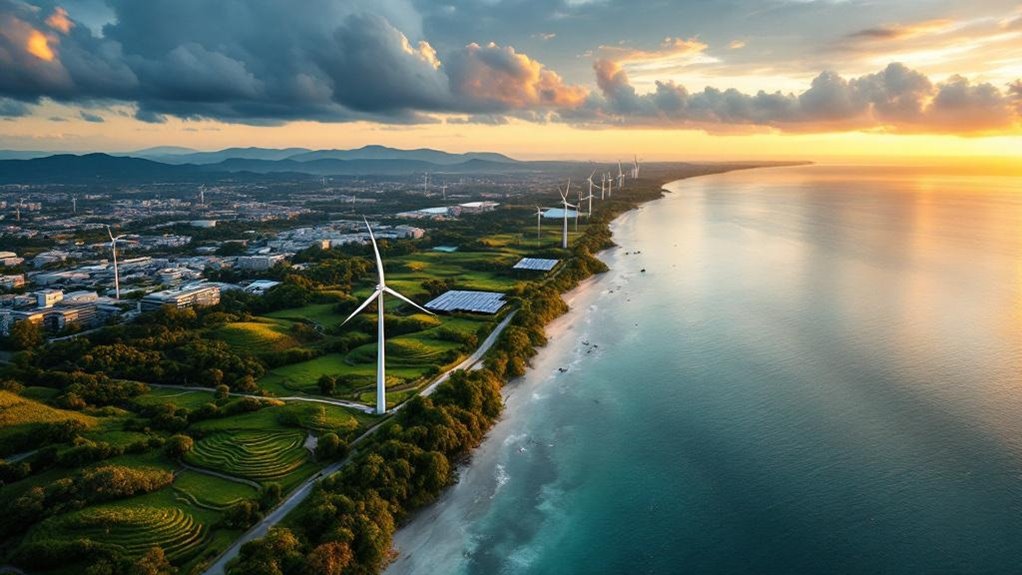Southeast Asia’s climate finance landscape requires substantial investment of US$3-5 trillion by 2050 to achieve net-zero targets, with annual funding needs of US$180 billion through 2030 for Paris Agreement commitments. Key challenges include regulatory uncertainties, limited private sector participation, and ineffective public-private partnerships across major economies like Indonesia, Vietnam, and Thailand. The region’s shift toward sustainable finance presents a US$1 trillion annual opportunity by 2030, with emerging mechanisms poised to transform the investment ecosystem.
The Scale of Climate Finance Requirements

While Southeast Asia’s climate finance landscape presents complex challenges, the sheer magnitude of required funding to address climate change in the region stands as the most pressing concern.
Regional studies indicate an unprecedented need for sustainable investments, with projected requirements ranging from US$3 to US$5 trillion by 2050 to achieve net-zero targets.
The scale of climate adaptation and resilience funding demands significant financial innovations, as current investment strategies fall drastically short. Thailand’s recent Green Taxonomy launch represents a crucial step toward meeting these massive funding requirements.
Country ownership principles are essential for ensuring effective climate finance distribution across Southeast Asian nations, helping coordinate regional funding efforts.
ASEAN nations must increase their funding mechanisms by 4-7 times present levels to meet Paris Agreement commitments, with annual requirements reaching US$180 billion through 2030.
Energy transformation initiatives alone necessitate US$70 billion annually, while sustainable transport requires US$40 billion per year, highlighting the urgent need for enhanced economic resilience across the region.
Current Investment Landscape and Funding Gaps
Despite substantial capital availability within Southeast Asia’s commercial banking sector, the current investment landscape reveals significant disparities between existing funding flows and the region’s climate finance requirements.
The region faces an estimated US$7 billion concessional finance gap between 2026 and 2030 for achieving net-zero targets, with sustainable investment opportunities particularly constrained by regulatory uncertainties and fragmented policy frameworks. Sustainability-linked bonds are increasingly being utilized to attract institutional investors and reduce financing barriers in the region.
While private financing mechanisms like blended finance structures are emerging to bridge this gap, several sectors remain chronically underfunded, especially sustainable transport and climate adaptation initiatives. The transition to sustainable bioeconomy presents a trillion-dollar opportunity that could help close these funding gaps significantly.
The Singapore government’s US$500 million commitment to FAST-P exemplifies public sector leadership, yet broader private sector mobilization continues to fall short of required levels, particularly affecting smaller developers and early-stage projects that struggle to access necessary capital.
Key Regional Players and Emission Profiles

Southeast Asia’s climate finance landscape is dominated by five key nations – Indonesia, Vietnam, Thailand, Malaysia, and the Philippines – which collectively account for the majority of regional emissions and clean energy investment activities.
Indonesia stands as the preeminent carbon emitter, responsible for over one-third of ASEAN’s greenhouse gas emissions, while Singapore, despite its limited emissions profile, has emerged as the region’s premier hub for green finance innovation and carbon market development.
The ASEAN+3 framework, which includes China, Japan, and South Korea, has strengthened regional climate collaboration through enhanced policy coordination and cross-border investment initiatives, particularly in renewable energy infrastructure and sustainable forestry projects.
Similar to Africa’s regional disparities, Southeast Asian climate finance flows remain concentrated among the largest economies, creating challenges for smaller nations seeking funding for climate initiatives.
Top Regional Carbon Emitters
As five key nations emerge as the primary drivers of carbon emissions across Southeast Asia, their collective impact accounts for 115.3 million tons of CO2-equivalent carbon credits over the past decade. Indonesia and Vietnam lead regional emission trends, with their substantial industrial growth and energy sector expansion driving carbon trading volumes. The integration of clean energy technologies has become crucial for these nations, as demonstrated by their potential to prevent up to 7% of global energy-related CO2 emissions annually. Private sector investments have surged by 52% in 2023, accelerating the region’s transition to sustainable energy solutions.
| Country | Primary Emission Sources | Market Position |
|---|---|---|
| Indonesia | Coal Power, Deforestation | Largest Emitter |
| Vietnam | Industrial Growth, Fossil Fuels | Second Largest |
| Singapore | Energy-Intensive Industries | Trading Hub |
Without significant policy interventions, regional emissions are projected to increase by 35% by mid-century. Malaysia and Thailand maintain substantial industrial bases, while Singapore, despite its smaller absolute emissions, functions as the region’s premier carbon trading hub, facilitating critical market mechanisms for environmental compliance and credit trading.
Clean Energy Investment Leaders
While China maintains its position as the dominant public investor in Southeast Asia’s clean energy landscape with contributions exceeding USD 2.7 billion, the region’s renewable energy development has attracted a diverse array of international and regional stakeholders.
Notable players include I Squared Capital, which supports initiatives like the Berde Renewables Collaboration Summit, with Berde targeting 5,000 megawatts of distributed energy deployment across the region. Following Latin America’s sustainable bond success, Southeast Asian markets are increasingly exploring green financing options.
Vietnam and Thailand have emerged as pivotal markets, with Vietnam leading solar implementation through its impressive 17.08 GW installed capacity. Japan has demonstrated significant commitment through clean technology investments of USD 2.45 billion from 2013 to 2023.
The region’s ambitious trajectory aims to expand renewable energy capacity from 124.61 GW in 2025 to 178.06 GW by 2030, catalyzed by China’s investment strategies and potential collaboration with Australia to accelerate the green energy shift.
ASEAN+3 Climate Collaboration
Through its strategic collaboration framework, the ASEAN+3 alliance has established itself as a pivotal force in regional climate action, encompassing the ten ASEAN member states alongside China, Japan, and South Korea in a detailed partnership focused on environmental sustainability and economic resilience. Regional partnerships have intensified through collaborative initiatives targeting emission reduction and sustainable practices. Building on the recent ACCPC in Siem Reap, the alliance continues to strengthen its preparatory measures for international climate negotiations.
| Key Players | Primary Contributions | Environmental Impact |
|---|---|---|
| China | Economic Investment | Carbon Reduction |
| Japan | Technical Support | Clean Energy |
| South Korea | Policy Framework | Air Quality |
The alliance faces significant challenges amid rapid urbanization and industrialization, with member states implementing extensive policy frameworks to address rising carbon emissions. ASEAN climate initiatives, supported by the Environmental Ministers Meetings and strategic partnerships with the GCC, demonstrate the region’s commitment to sustainable development and environmental stewardship.
Cross-Border Cooperation and Policy Frameworks

Cross-border climate finance cooperation in Southeast Asia operates through multiple interconnected frameworks, with ASEAN+3 serving as the primary platform for coordinating regional climate action and sustainable finance initiatives.
The China-ASEAN Green Partnership has emerged as a vital bilateral mechanism for channeling climate investments and technical expertise, while facilitating knowledge transfer between participating nations. These initiatives are expected to generate $120 billion in economic value through prioritized climate solutions.
The Mekong Basin Investment Initiatives exemplify subregional cooperation, bringing together riparian states to address climate vulnerabilities through coordinated infrastructure funding and environmental protection measures.
ASEAN+3 Climate Action Framework
Spearheading regional climate initiatives, the ASEAN+3 Climate Action Framework establishes extensive cross-border cooperation mechanisms among ASEAN member states plus China, Japan, and South Korea.
The framework prioritizes climate policy integration and regional collaboration through synchronized national strategies and joint projects in climate-smart agriculture, low-carbon energy, and disaster risk management. A thorough database tracks national climate commitments and sectoral roadmaps, while the ASEAN Climate Change Strategic Action Plan 2025-2030 operationalizes objectives from the ASEAN State of Climate Change Report. The framework’s dual focus on adaptation and mitigation strategies ensures comprehensive climate action across the region.
Implementation is supported by the ASEAN Working Group on Climate Change, which coordinates cross-sectoral actions and monitors progress.
The framework’s institutional structure facilitates knowledge sharing, data exchange, and best practice dissemination, while engaging both public and private sector stakeholders to enhance resource mobilization and implementation capacity.
China-ASEAN Green Partnership
A landmark partnership between China and ASEAN represents one of Asia’s most significant climate finance initiatives, establishing extensive frameworks for green development and sustainable economic cooperation across the region. The alliance prioritizes cross-border investment in green technology and sustainable agriculture through coordinated policy frameworks and innovative financing mechanisms. With a combined GDP of $24.87 trillion, the partnership demonstrates unprecedented economic potential for advancing climate initiatives in the region.
| Focus Area | Key Initiatives | Outcomes |
|---|---|---|
| Policy Integration | Joint standards development | Harmonized regulations |
| Finance Mechanisms | Green bonds and loans | Increased capital flows |
| Technology Transfer | Clean energy solutions | Enhanced capabilities |
The partnership addresses critical funding gaps through strategic public-private collaborations, aiming to meet ASEAN’s USD 422 billion climate finance requirements by 2030. This institutional framework facilitates knowledge sharing, capacity building, and technological advancement across participating nations.
Mekong Basin Investment Initiatives
Through coordinated multilateral efforts, the Mekong Basin Investment Initiatives represent a thorough framework for transboundary cooperation among riparian states, encompassing water resource management, trade facilitation, and sustainable development across the Greater Mekong Subregion (GMS).
These transboundary resource management programs are reinforced through formalized Memorandums of Understanding between national governments and regional institutions, establishing clear mechanisms for cross-border collaboration. The Belt and Road Initiative has significantly enhanced infrastructure investment across the region to promote economic development and stability.
The Mekong investment strategies integrate multiple dimensions, including the development of special economic zones, enhancement of border facilities, and implementation of the Mekong Integrated Water Resources Management Project.
Institutional support from organizations such as the Mekong River Commission (MRC) and technical assistance from GIZ further strengthen regional capacity building, while policy frameworks emphasize sustainable hydro-development and equitable resource sharing among member states.
Economic Opportunities and Job Creation Potential
Southeast Asia’s shift to a green economy represents one of the region’s most significant economic transformations, with projected opportunities valued at US$1 trillion annually by 2030.
The change encompasses multiple sectors, driving substantial green job creation through sustainable investment in renewable energy, infrastructure, and agriculture.
Sustainable investments across energy, infrastructure, and agriculture sectors are powering the creation of green jobs throughout Southeast Asia.
The region anticipates 6-8 million new positions by 2030, with renewable energy sectors alone generating 3-4 million jobs.
Green construction and urban development are expected to employ 1.5 million workers, while sustainable agriculture initiatives could create 2 million rural opportunities.
Professional services are expanding rapidly, particularly in sustainable finance, ESG analysis, and climate risk assessment.
The economic benefits extend across urban and rural areas, supporting both large-scale infrastructure projects and local SME development in climate-related goods and services.
Blended finance approaches will be crucial to unlocking these economic opportunities by connecting project developers with appropriate financing sources.
Barriers to Climate Finance Mobilization
Despite considerable economic opportunities in Southeast Asia’s climate shift, substantial barriers impede the effective mobilization of climate finance across the region. The landscape is characterized by complex regulatory hurdles, heightened investment risks, and insufficient financial instruments to facilitate large-scale funding. With regional climate finance needs reaching up to $1 trillion annually by 2035, the gap between available funding and required investment continues to widen dramatically.
Policy uncertainty and fragmented regulatory frameworks across ASEAN nations considerably constrain private sector participation, while limited capacity building initiatives and technical expertise hinder project implementation at national and subnational levels.
The region faces critical challenges in establishing effective public private partnerships, with current frameworks failing to optimize blended finance solutions. Regional collaboration remains underdeveloped, as evidenced by inconsistent climate finance policies and inadequate knowledge-sharing platforms.
These barriers are further compounded by strict eligibility requirements from international climate funds and underdeveloped carbon markets.
National Strategies for Green Transition
As nations across Southeast Asia embrace ambitious decarbonization goals, extensive green shift strategies have emerged to systematically transform key economic sectors and align with global climate imperatives.
Regional green policies have demonstrated substantial progress, with renewables surpassing coal in installed capacity and detailed transition roadmaps developed by major polluting organizations. Public sector institutions are increasingly focused on sustainability reporting standards to ensure transparency and accountability in their green initiatives.
Southeast Asia’s green transition gains momentum as renewable capacity outpaces coal, backed by comprehensive industry transformation plans.
- ASEAN’s collaborative framework targets 35% renewable energy in installed capacity by 2025, driving coordinated policy implementation.
- Vietnam leads regional transformation with 19 GW of solar and wind capacity through robust national initiatives.
- Government-driven grid modernization efforts could contribute $25 billion to GDP and create 200,000 jobs by 2030.
- Bioeconomy integration emphasizes sustainable agriculture and land restoration, positioning Southeast Asia for leadership in the projected $30 trillion global bioeconomy market.
Social and Environmental Impact Assessment
The thorough integration of social and environmental impact assessments within Southeast Asia’s climate finance landscape represents a critical framework for guaranteeing sustainable and equitable project outcomes.
These assessments prioritize extensive community engagement through stakeholder workshops and local perspective integration.
Regional frameworks mandate standardized environmental risk evaluations alongside social impact analyses, with particular emphasis on biodiversity conservation and ecosystem protection.
With 40% of projects in early development stages across Southeast Asia, impact assessments play a crucial role in shaping technical assistance requirements and implementation strategies.
ASEAN’s Climate Finance Mobilization and Access Strategy incorporates detailed protocols for impact assessment that align with international standards while adapting to local contexts.
Monitoring and reporting mechanisms guarantee transparency through quantitative and qualitative data collection, establishing accountability through community feedback loops.
This systematic approach to impact assessment enables the identification of potential risks while maximizing positive outcomes for both environmental sustainability and social inclusion.
Frequently Asked Questions
How Can Individual Citizens Participate in Climate Finance Initiatives in Southeast Asia?
Individual citizens can actively participate in climate finance through multiple pathways that emphasize community engagement and funding opportunities.
They can invest in retail green bonds and climate-focused investment products, support local renewable energy cooperatives through crowdfunding platforms, and join community-based sustainability initiatives.
Additionally, citizens can leverage digital banking tools to track carbon footprints, participate in eco-loyalty programs, and engage in policy advocacy through public consultations and grassroots organizations.
What Specific Skills Are Needed for Jobs in Southeast Asia’s Green Economy?
The green economy in Southeast Asia demands a diverse skillset centered around sustainable development and green technologies.
Key requirements include:
- Technical expertise in renewable energy systems, energy efficiency, and environmental engineering
- Digital proficiency with data analytics, IoT implementation, and smart infrastructure management
- Regulatory knowledge of ESG reporting, carbon markets, and environmental compliance
- Project management capabilities for green initiatives
- Cross-cultural communication skills for stakeholder engagement and capacity building across the region
How Do Natural Disasters Affect Climate Finance Investment Decisions in the Region?
Natural disasters greatly shape climate finance decisions through multiple pathways:
- Disasters strain public budgets by forcing reallocation of funds toward immediate relief, reducing capital available for planned climate initiatives.
- Heightened disaster preparedness requirements increase project costs and complexity, impacting investment feasibility.
- Investment risks escalate due to concerns about project viability and returns in disaster-prone areas.
- Only 5% of tracked climate finance reaches Southeast Asia despite high vulnerability, reflecting how disaster risks deter investments.
Which Southeast Asian Universities Offer Specialized Training in Climate Finance?
Several Southeast Asian universities offer specialized climate finance education incorporating climate policy and financial instruments:
- National University of Singapore provides a thorough MSc in Sustainable and Green Finance.
- Nanyang Technological University integrates sustainable finance into its Financial Engineering program.
- Universiti Teknologi Malaysia delivers climate finance modules through business degrees.
- Asian Institute of Management incorporates climate finance components in its Development Management curriculum.
- Singapore Green Finance Centre offers executive training through its Climate Finance Academy.
What Role Do Indigenous Communities Play in Regional Climate Finance Projects?
Indigenous communities play a crucial role in climate finance projects through their traditional ecological knowledge and community-driven approaches.
These communities lead initiatives focused on sustainable resource management, forest conservation, and climate-resilient agriculture. Their indigenous knowledge systems inform project design and implementation, while community engagement guarantees local priorities are addressed.
Through direct funding mechanisms like the Nusantara Fund, indigenous groups are increasingly empowered to manage and execute climate finance projects that benefit both environmental conservation and local livelihoods.
Conclusion
Southeast Asia’s climate finance landscape requires coordinated regional action to bridge the substantial funding gaps and overcome institutional barriers. While challenges persist in policy harmonization and cross-border cooperation, the region presents significant opportunities for sustainable economic growth through green investments. Success depends on strengthening regulatory frameworks, expanding public-private partnerships, and implementing robust impact assessment mechanisms to guarantee effective allocation of climate finance resources.
References
- https://www.bain.com/insights/southeast-asias-green-economy-2025/
- https://zerocarbon-analytics.org/wp-content/uploads/2025/05/2025-05-The-race-to-invest-in-Southeast-Asias-green-economy.pdf
- https://www.climatebonds.net/2025/05/thailand’s-taxonomy-launch-new-reference-climate-aligned-investment-southeast-asia
- https://www.alliancemagazine.org/blog/southeast-asia-climate-finance-needs-outstrips-funding-flows-warns-report/
- https://iesr.or.id/wp-content/uploads/2024/11/Putra-Maswan-IESR-_-CLIMATE-FINANCE-IN-SOUTHEAST-ASIA.pdf
- https://zerocarbon-analytics.org/archives/economics/the-race-to-invest-in-southeast-asias-green-economy
- https://www.climateworkscentre.org/news/southeast-asia-needs-serious-money-to-get-to-net-zero/
- https://www.ecosperity.sg/en/insights/articles/southeast-asia-green-economy-2025-report
- https://www.adb.org/news/events/climate-finance-landscape-southeast-asia-gaps-challenges-opportunities
- https://www.climatepolicyinitiative.org/publication/global-landscape-of-climate-finance-2024/

